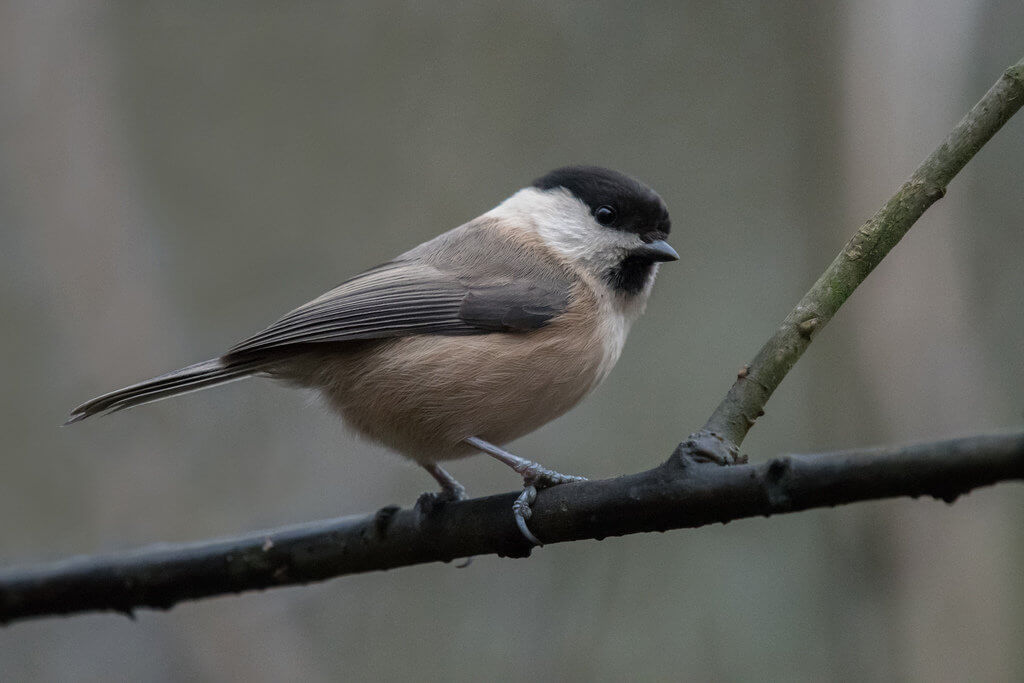
Tim writes: In 1897 two German Ornithologists (Ernst Hartert and Otto Kleinschmidt) were looking through a series of Marsh Tits in the British Museum when they spotted a couple of Willow Tits that had been wrongly labelled. The same year some fresh specimens were collected in Coalfell Wood, Finchley and three years later Willow Tit was officially added to the British List. Willow Tit was described new to science back in 1824 but nobody realised they were a common and widespread British bird. Alas they are no longer common and not nearly so widespread as they have declined rapidly in recent decades. They have completely disappeared from the south east of England, their type locality in Britain.
Willow Tits are the most rapidly declining resident bird in the UK. The British population fell by 91% between 1967 and 2010. Research on reasons for the decline is ongoing, but we know they prefer scrub to woodland, and also need standing dead wood as they excavate their own nest holes. The endemic British race kleinschmidti is the smallest and darkest of numerous races. It has deeper colour on the upperparts but the underparts are most distinctive with a buff wash on the underparts. The latest population estimate of the British kleinschmidti is 3400 pairs, but it continues to decline.
I photographed this one in West Yorkshire where they are scarce, but still regular.
Taken with Nikon D500 Nikkor 300mm f4 with 1.4x converter (420mm) set at f5.6 1/1000 ISO 11400
Mark writes:
I’m very grateful to Tim Melling for his images and the words that go with them.
Do you like them too?
[registration_form]
An interesting blog – thank you! If I have my facts correct, there are now less breeding pairs of Willow tits than there are Giant Pandas – yet for the most part Willow tits don’t get nearly the same level of public awareness.
Arlene – welcome to this blog. Thank you for your comment.
Thanks Arlene. Someone once said to me that the British race of Willow Tit was rarer than Giant Panda but the Panda definitely wins the rarity prize. Regardless of which estimate you use there are fewer than 2000 individual Giant Pandas left in the wild. Whereas there are around 7000 breeding individual British Willow Tits, plus a number of young non-breeding individuals.
Thanks Tim. It’s a great story with what looks like a very sad ending. What else is out there defying identification? Your 1824 reference is fascinating – can you give further details please?
Another thing about Willow Tits is that they follow the ‘look or sound different signalling rule’. E.g. Chiffchaff/Willow Warbler which are of course very similar to look at but very different song-wise. Then with Blackcap/Garden Warbler it’s the other way round (I still can’t separate their songs). Then there’s a rather nice intermediate example with Firecrest and Goldcrest – plumage quite similar and songs quite tricky at times – but these difficulties of identification are nothing compared to the above.
I have only heard the full song of the Willow Tit once. It was performing in an ancient Wild Cherry (Gean) which was in full bloom. The bird’s song had notes of Nightingale-like quality, completely unlike the Marsh Tit’s monotone rattle.
murray – the fairly useful mnemonic for Blackcap and Garden Warbler is that B has a Brief song whereas G Goes on a bit. Also B has more tuneful notes and G is more scratchy. But they can be tricky – and I always always always try to see my first singing G of the year to be sure.
Thanks Mark. I’ll work on that.
‘Monotone rattle’. For the sake of some accuracy that should be ‘one note chant’.
Further to Goldcrest/Firecrest, on occasions they seem to sing against each other. It appears that Coal and Great Tits sometimes do that too. It’s as if the birds themselves get a bit confused. Or is it a confused observer and/or a lack of observer accuracy?
murray – I’ve wondered the same thing.
Many thanks Murray. Apologies but the date should have been 1827 not 1824. Willow Tit was first described new to science by the Swiss naturalist Thomas Conrad von Baldenstein from locally collected specimens and was published in Neue Alpina Vol 2 page 31 (in 1827). I’m pretty sure that Willow and Marsh Tits choose the right partner by sound, though I rarely see the two species in the same area. The usual calls I hear are the buzzing eeez-eeez-eeez, but in early spring they perch high in the willows and sing a repeated tuneful single note that is quite similar to the slow trill of a Nightingale.
Thanks for that reference Tim.
Clive Simsons “A Bird Overhead” (a brilliant read for anyone interested in bird nesting), gives a nice tale of the birds separation from Marsh Tit in this country.
As a typically unobservant ,cold searching, boyhood nester, Willows were the easiest tits to find.
Their habit of excavating nest holes in dead Elder, leaving a tell tale white hole,gave the game away.
It was never particularly wet ground, there is now at least five times the amount of scrub woodland, and plenty of Elder.
Where are the Willow Tits ?.
I am very lucky that we still get Willow Tit on the Reserve where I volunteer (Avenue Washlands), we have caught & ringed this years young too. I’m not sure if I’ve made this up or not but I seem to remember reading about how putting up too many nest boxes for Blue/Great tit can lead to a loss of Willow Tit. Has anyone else heard this?
Stewart, the boyhood nesting grounds I frequented were upstream of the avenue.
Due to retire shortly, I hope to spend a bit of time next season revisiting old haunts. Willow Tit will be one of my target species.